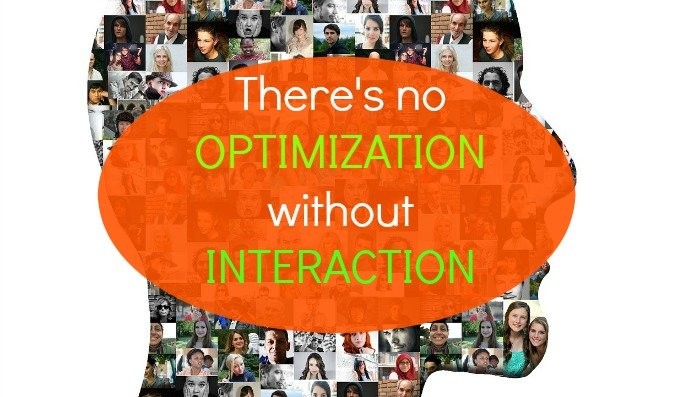
There is No Optimization Without Interaction
Web marketing cannot survive without interaction. Little do people realize that web marketing has always depended on relationships to succeed. Since Google created an algorithm that used links, web marketing depending on these links to survive.
And how do you get links? Build relationships.
Ok, that's the best way to get legitimate links. We'll leave behind the link farms and link farms "SEOs" created in years past to manipulate link algorithms. True links were developed almost entirely on the basis of building a relationship with someone else and providing something of value.
And how do you build relationships? Interaction.
Yeah, I know, we're getting pretty deep into the basics here, but that's where it all starts, and that's the foundation of a growing web presence. Your online interactions form the basis for establishing links, getting business, communicating authority, or improving (or screwing up) your reputation. Basically, this is how you get noticed and make an impression on others.
As a web marketer, there are three main focuses of our interaction and authority building processes: Social media, reputation management, and content marketing. Call this the authority trifecta, if you wish. Almost all online interaction revolves around these three things.
Social Media is a Tool, Not a Strategy
Many people think of social media as a strategy to build their business. It's not. You can have a social media strategy (and you should!) but social media is a tool you use to execute that strategy. Being on social media alone won't grow your business.
One of the big mistakes businesses often make with social media is they use it as a promotion channel. It's not. It's an engagement channel. If you're just pushing out your own content on social media, you're failing at it. Use it to engage and interact with your audience. Get involved in conversations, ask and answer questions, help people out, share content (from other people), and be personable.
For the most part, only 20% of your social media postings should be about you and your own content. The rest should be generating or participating in dialogues. No, it's not easy and it does take time, but it's time well spent.
People love attention, and they love those who give it to them. Which means if you give them lots of attention they will give you attention. It's the circle of life, baby!
Who's Looking After Your Reputation?
Everybody needs to manage their reputation online. Larger companies are going to have to spend more time on this than smaller companies, but everybody needs to be aware of what people are saying about them.
Whether you're engaged on social media or not, you need to know when your company is mentioned. Good posts and tweets should be responded to positively and negative posts and tweets should be responded to . . . positively.
Look for opportunities to engage with your audience. If there is a problem, seek to fix it as quickly as possible. If someone is disgruntled, seek to understand the issue and then find a remedy.
Very often, people tweet problems, hoping someone is monitoring. If you don't provide an adequate reply very quickly, the perception of your brand will continue to decline. A negative comment that gets responded to and resolved quickly usually results in an increase in brand reputation.
Same with blogs and links. Monitor mentions of your company and new links pointing to your site. Make sure they are good references, and if not, seek to find a remedy. You may not always be able to fix the problem, but how you handle the problem can often lead to more positives than the initial negative.
Use Content to Distribute Knowledge and Build Authority
While social media is a great way to build authority, your opportunities there are limited to whatever each particular network allows. A way to bypass that is to build content on your own site and then use social media to promote it.
There are limitless opportunities to create valuable, engaging. and otherwise useful content. The graphic above outlines just seven types of content: Workshops, Webinars, Videos, Ebooks, Whitepapers, Tools, and Blogs. But those are by no means the only opportunities, just the most obvious.
Every company should be investing in at least one of these areas, if not several or all of them. With limited resources, the easiest is blogs, but the rest can build from there. The smart marketer will build content through one channel and figure out how to turn that same content into something useful on another. This blog post is a great example. It started out as part of a workshop presentation. That workshop has now been translated into several blog posts, utilizing the imagery from the slide deck.
That's not working harder, that's working smarter!
Content begets authority, authority begets interaction, interaction begets reputation, reputation begets authority and they all beget opportunities for more content. All of these go hand in hand, helping you build your web presence through smart interaction with our audience.
Stoney deGeyter is the author of The Best Damn Web Marketing Checklist, Period and the CEO & Founder of Pole Position Marketing, a leading online marketing strategy company that been working with organizations to improve their online presence since 1998. Additionally, Stoney is a well-known speaker at industry conferences nationwide. He is also a prolific blogger, having written for a number of popular industry blogs and Pole Position Marketing's own E-Marketing Performance blog. Want to velocitize your web marketing? Stoney and Pole Position Marketing are the crew you need. Follow him at @StoneyD, and @PolePositionMkg.



Digital Marketing | Client Success | Business Development | Content Marketing Manager | Marketing Campaigns, Ads
9yI agree with you on this 100%. Thanks for this great piece.
LeadGenerationAndSales.com. Content Marketing.
9yI've always supported the fact that you need to "attract" links, not "build" links.